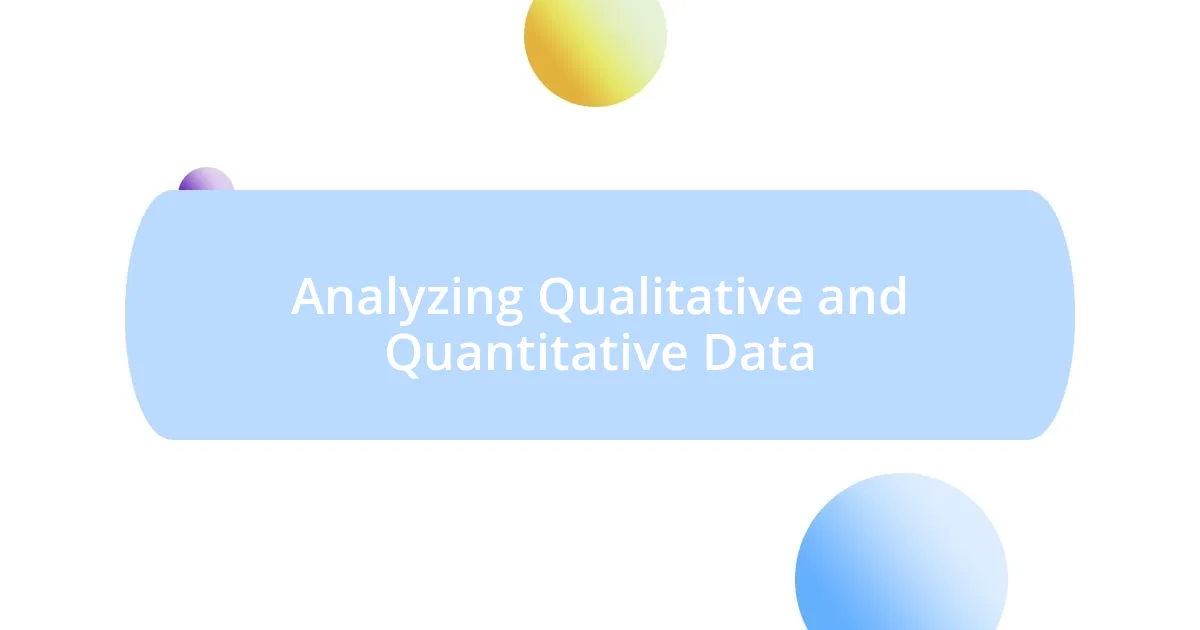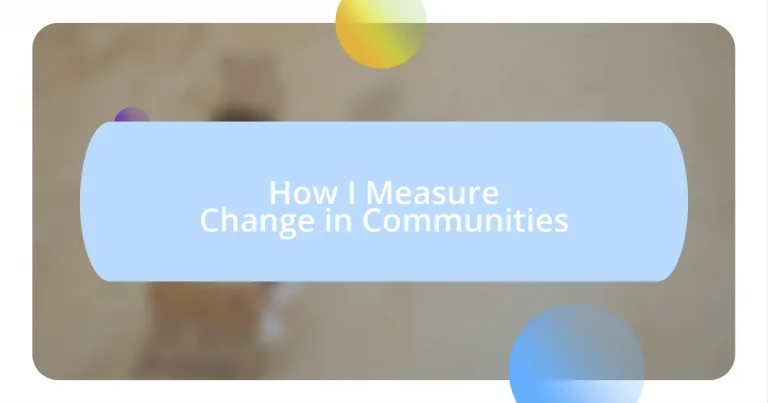Key takeaways:
- Community change measurement is not just about quantitative data; it also involves understanding the narratives and emotions behind the numbers.
- Engaging community stakeholders fosters ownership and deeper insights, transforming evaluation from a data-gathering exercise into a collaborative process.
- Utilizing a mix of qualitative and quantitative data enhances understanding, revealing both the “what” and the “why” of community transformations.
- Regular feedback loops and continuous improvement strategies empower communities to adapt and create effective, collaborative solutions.

Understanding Community Change Measurement
Measuring change in communities can often feel like trying to catch smoke with your bare hands. During my work with local organizations, I’ve seen firsthand how community-driven metrics can reveal stories hidden beneath the surface, like improved access to resources or shifts in community morale. Have you ever noticed how some changes can be subtle yet transformative? It’s in these nuanced shifts that real impact lives.
One memorable experience that stands out for me involved a neighborhood revitalization project where we employed surveys to track resident satisfaction over time. Initially, the responses seemed lukewarm, but over the months, I began to see glimmers of hope in the feedback. As community gardens flourished and collective events started drawing in more participants, the sentiment shifted dramatically. This taught me that measurement isn’t just about numbers; it’s about understanding the narrative behind those figures.
Ultimately, the essence of community change measurement lies in its ability to reflect the lived experiences of the people involved. It’s far too easy to slip into a numbers-driven mindset, but have you ever stopped to consider the emotions behind the data? For instance, while statistics may show an increase in community engagement, the laughter and tears shared during events are the real indicators of connection. By embracing both qualitative and quantitative measures, we can craft a fully realized picture of transformation that resonates deeply with everyone involved.

Identifying Key Change Indicators
Identifying pertinent change indicators in a community is like honing in on the heartbeat of transformation. From my experience, it’s essential to look beyond surface-level metrics and dive into the aspects that really reflect the community’s journey. For instance, while examining the impact of a youth mentorship program, I noticed a shift in not just participation numbers but also in the way families interacted with each other. A change in the neighborhood’s spirit often reveals itself through new conversations at the local park or the eagerness of kids to play together after the program’s sessions.
Here are some key change indicators to consider:
- Community Sentiment: Regularly gauge feelings through informal chats or more structured surveys.
- Participation Rates: Look at engagement levels in local events; a rise can signal increasing community interest.
- Resource Accessibility: Track improvements in access to vital services, like food or healthcare.
- Collaboration Initiatives: Observe new partnerships among community organizations that signify trust and collective effort.
- Safety Perceptions: Monitor shifts in how safe residents feel in their environment, which can indicate broader changes in community cohesion.
By focusing on these indicators, I’ve seen how they can illuminate a community’s growth narrative. Each indicator reflects a real-life story waiting to be told, adding a rich layer to the overall understanding of change.

Selecting Appropriate Data Collection Methods
Selecting the right data collection methods can significantly impact how effectively we measure change in a community. Based on my experience, both surveys and interviews can capture valuable insights, but they serve different purposes. Surveys might provide a broad overview of community sentiments, capturing many voices, while interviews allow for deeper storytelling. Have you ever had a conversation that completely changed your perspective on an issue? That’s the magic interviews can offer.
When I led a community health initiative, we utilized focus groups to delve into residents’ experiences. It was fascinating to hear their stories unfold—everything from routine struggles to poignant moments of resilience. This qualitative approach revealed layers of complexity that a simple survey would have glossed over. While quantifiable data is essential, I truly believe qualitative methods can ignite genuine empathy and understanding within the community.
As you weigh your options, consider factors like the community’s size, demographics, and the specific changes you’re tracking. A blend of qualitative and quantitative methods often yields the richest insights. By choosing appropriately, you can mirror the community’s dynamics, much like how a well-composed symphony reflects the true spirit of its musicians.
| Data Collection Method | Strengths |
|---|---|
| Surveys | Broadly captures quantitative data from many participants |
| Interviews | Provides in-depth, qualitative insights through personal stories |
| Focus Groups | Encourages discussion and interaction among participants, revealing community sentiment |
| Observations | Captures context and real-time behaviors, grounding data in actual practices |

Analyzing Qualitative and Quantitative Data
When it comes to analyzing qualitative and quantitative data, both play vital roles in understanding community change. In one project I was involved with, I remember feeling the impact of numbers juxtaposed with stories. For instance, we saw a 30% increase in attendance at community events. But what truly struck me were the heartfelt testimonials about how those events fostered friendships that transformed individual lives. The depth of emotion in those accounts gave context to the numbers, making the data resonate on a personal level.
In my experience, qualitative data often uncovers the ‘why’ behind the ‘what.’ One time, while analyzing feedback from a community garden initiative, a resident shared how growing vegetables created a bonding experience among neighbors. This narrative not only highlighted the positive outcomes but also revealed underlying sentiments of belonging and teamwork. Have you ever asked someone about their experience with a community project and found it opened a floodgate of emotions? That’s what qualitative insights can do; they provide a human touch to statistical dry data.
On the other hand, quantitative data ensures that trends are captured accurately and provide a foundational overview of change. I recall sifting through demographic information that showed a growing diversity in our neighborhood. This data prompted discussions about inclusivity and representation in community initiatives. Balancing these two forms of data ultimately allowed me to tell richer, more compelling stories of transformation. It’s like weaving a tapestry; each thread, whether numerical or narrative, contributes to a holistic view of where a community stands and where it might be headed.

Engaging Community Stakeholders in Evaluation
Engaging community stakeholders in evaluation is critical for capturing a comprehensive picture of change. One memorable experience I had was when we brought together local leaders for an evaluation workshop. The conversations flowed with passion—people shared not just their data, but their dreams for the community. It was in those moments that I realized how vital it is to involve stakeholders deeply; their stakes and insights shape the direction of any initiative.
I’ve often seen that involving individuals who are directly affected by changes creates a sense of ownership. During a project aimed at improving neighborhood safety, we invited residents to discuss their concerns and aspirations. One person shared a story about how streetlights had transformed their evening walks, providing a feeling of security. I could see the other participants nodding, resonating with that shared experience. By engaging them, we built a collaborative spirit that turned evaluation into an empowering process rather than a mere data-gathering exercise.
Reflecting on these interactions, I’ve come to appreciate the power of diverse perspectives. When I worked with a community art project, stakeholders included artists, parents, and even local businesses. Their unique viewpoints brought depth to our evaluation metrics. Have you ever considered how the voices of the community could shift your perspective on project success? Listening to them not only enriched the evaluation but also fostered a collective commitment to long-term change. Engaging stakeholders isn’t just about gathering data; it’s about weaving their narratives into the fabric of community growth.

Communicating Findings to the Community
Communicating findings to the community is more than just sharing data; it’s about connecting on a human level. I remember a time when we organized a neighborhood gathering to present our research on local air quality. Instead of just throwing numbers at them, we turned it into a storytelling event. Residents shared their experiences, which highlighted the personal impact of the findings. It was eye-opening to see how those narratives overshadowed the statistics; suddenly, a spike in pollution levels didn’t just mean numbers—it represented kids with asthma and families worried about health.
The emotional resonance of our findings became even clearer when someone asked how we could collectively address the issues raised. I encouraged them to brainstorm solutions right on the spot, transforming a presentation into a dialogue. This approach not only empowered the community to take action but also reaffirmed my belief that effective communication should spur collaboration. How often do we see data become a catalyst for real change? In this case, it wasn’t just about informing the community; it was about creating a shared mission to improve our environment.
After that experience, I realized that visuals can be powerful tools in communicating findings. In another project, we created infographics that captured trends on community health, blending imagery with data. People engaged with the visuals, sparking discussions about the meanings behind the numbers. Someone even remarked that it helped them feel seen and understood; they could relate their daily lives to the statistics presented. Have you ever seen a piece of art reflect your own experiences? That’s exactly the connection I aimed to create, illustrating how metrics weave into the fabric of everyday life. By prioritizing clarity and engagement, I’ve found that we can foster a community that not only understands the data but feels empowered by it.

Implementing Continuous Improvement Strategies
Implementing continuous improvement strategies is essential for sustaining positive change in communities. I recall a time when we decided to integrate regular feedback loops into our project on educational resources. By setting up quarterly check-ins with teachers and students, we were able to adapt our approaches swiftly. How often have you felt a project could have succeeded better with a few timely adjustments? This experience reinforced my belief that being proactive and receptive to feedback invites collaboration and enhances effectiveness.
As I engaged with different community groups, I realized the importance of holding workshops focused solely on problem-solving. One memorable session involved brainstorming solutions for access to fresh produce. Rather than emphasizing our initial plans, we encouraged participants to share their ideas. The room buzzed with enthusiasm as people discussed potential partnerships with local farmers. It became clear to me that fostering an environment where everyone can voice their insights leads to powerful, community-driven solutions.
In another instance, I implemented a method called Plan-Do-Study-Act (PDSA) cycles to test out new programs. I vividly remember rolling out a pilot project aimed at improving literacy rates in a low-income neighborhood. By analyzing the results and refining our approach after each cycle, we witnessed noticeable progress. It made me ponder: wouldn’t we all benefit from a structured way to reflect on our efforts regularly? This iterative process taught me that continuous improvement isn’t just a buzzword; it’s an evolving journey that embraces learning from both success and failure.














